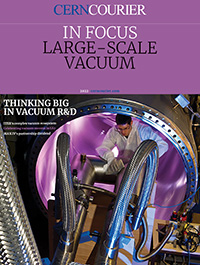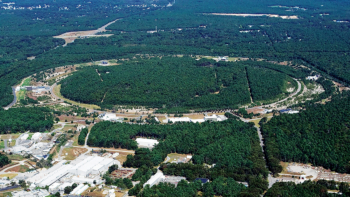

Particle beams require extremely low pressure in the pipes in which they travel to maximise beam lifetimes and minimise backgrounds in physics detectors. This challenge drives much of today’s vacuum R&D towards simulating, controlling and mitigating the direct and indirect effects of particle beams on material surfaces. CERN brings surface-physics specialists, thin-film coating experts and galvanic-treatment professionals, together with designers and others dedicated to the operation of large vacuum equipment. This makes it one of the world’s leading R&D centres for extreme vacuum technology, for projects at CERN and beyond.
All of the articles from the print edition are available online, or alternatively you can download a PDF version.

 Read article 'Hyperloop: think big, win big'
Read article 'Hyperloop: think big, win big'
Leybold’s Tom Kammermeier on the German manufacturer’s long-range bet on hyperloop vacuum-based transportation systems.
 Read article 'Surface treatment: secrets of success in vacuum science'
Read article 'Surface treatment: secrets of success in vacuum science'
Paolo Chiggiato and Leonel Ferreira explain the critical role that surface modification plays in big-science vacuum systems.
 Read article 'Vacuum metrology: made to measure'
Read article 'Vacuum metrology: made to measure'
A pan-European consortium is working towards an international standard for the commercial manufacture of ionisation vacuum gauges.
 Read article 'Collaboration yields vacuum innovation'
Read article 'Collaboration yields vacuum innovation'
CERN is home to a unique innovation ecosystem pioneering advances in vacuum science, technology and engineering
 Read article 'A joined-up vision for vacuum'
Read article 'A joined-up vision for vacuum'
ESS vacuum group leader Marcelo Juni Ferreira describes the essential role of vacuum technology in this next-generation neutron-science facility.
 Read article 'A unique vacuum environment'
Read article 'A unique vacuum environment'
Paolo Chiggiato describes the unparalleled vacuum developments that underpin CERN’s science.
 Read article 'The Synchrocyclotron and the PS: a comparison'
Read article 'The Synchrocyclotron and the PS: a comparison'
In the summer of 1960, the Courier compared and contrasted the 600 MeV Synchrocyclotron and the 28 GeV Proton Synchrotron
 Read article 'High voltage in vacuum'
Read article 'High voltage in vacuum'
This article from July 1969 looked into the future of very high voltage in vacuum.
 Read article '400 GeV machine vacuum and r.f. progress'
Read article '400 GeV machine vacuum and r.f. progress'
With construction of the Super Proton Synchrotron in full swing, the May 1975 issue of the Courier published a progress report on its vacuum and radio-frequency systems.
 Read article 'MAX IV paves the way for ultimate X-ray microscope'
Read article 'MAX IV paves the way for ultimate X-ray microscope'
Novel machine lattice produces brightest ever X-ray beams.
 Read article 'Much ado about nothing'
Read article 'Much ado about nothing'
In November 1972, CERN’s Roger Calder described in detail the unprecedented vacuum system of the world’s first hadron collider, the Intersecting Storage Rings.
 Read article 'High vacuum'
Read article 'High vacuum'
While the 27 km tunnel for the LEP electron–positron collider at CERN was being prepared, the Courier described non-evaporable getters used for its vacuum system.
 Read article 'Technological spinoffs from accelerators'
Read article 'Technological spinoffs from accelerators'
The May 1994 issue of the Courier featured an article by Oscar Barbalat about the industrial benefits of particle accelerators.
 Read article 'Molecular sticky tape'
Read article 'Molecular sticky tape'
The 1998 EPS-IGA prize for outstanding work in the accelerator field was awarded to CERN’s Cris Benvenuti for “major breakthroughs in achieving ultra-high vacua in storage ring...
 Read article 'CERN’s prowess in nothingness'
Read article 'CERN’s prowess in nothingness'
CERN is a world-leading centre for extreme vacuum technology, thanks to a wealth of in-house expertise and a constant flow of challenging projects
 Read about 'In focus: US accelerator projects'
Read about 'In focus: US accelerator projects'
Evolution, ambition and international collaboration underpin US accelerator initiatives